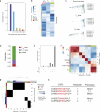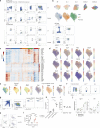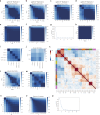Precursor central memory versus effector cell fate and naïve CD4+ T cell heterogeneity
- PMID: 39321257
- PMCID: PMC11448869
- DOI: 10.1084/jem.20231193
Precursor central memory versus effector cell fate and naïve CD4+ T cell heterogeneity
Erratum in
-
Correction: Precursor central memory versus effector cell fate and naïve CD4+ T cell heterogeneity.J Exp Med. 2024 Nov 4;221(11):e2023119310182024c. doi: 10.1084/jem.2023119310182024c. Epub 2024 Oct 30. J Exp Med. 2024. PMID: 39475498 Free PMC article. No abstract available.
Abstract
Upon antigenic stimulation, naïve CD4+ T cells can give rise to phenotypically distinct effector T helper cells and long-lived memory T cells. We computationally reconstructed the in vivo trajectory of CD4+ T cell differentiation during a type I inflammatory immune response and identified two distinct differentiation paths for effector and precursor central memory T cells arising directly from naïve CD4+ T cells. Unexpectedly, our studies revealed heterogeneity among naïve CD4+ T cells, which are typically considered homogeneous save for their diverse T cell receptor usage. Specifically, a previously unappreciated population of naïve CD4+ T cells sensing environmental type I IFN exhibited distinct activation thresholds, suggesting that naïve CD4+ T cell differentiation potential may be influenced by environmental cues. This population was expanded in human viral infection and type I IFN response-lined autoimmunity. Understanding the relevance of naïve T cell heterogeneity to beneficial and maladaptive T cell responses may have therapeutic implications for adoptive T cell therapies in cancer immunotherapy and vaccination.
© 2024 Deep et al.
Conflict of interest statement
Disclosures: Z.-M. Wang reported personal fees from Genentech outside the submitted work. V. Pascual reported grants from Sanofi Pasteur, and personal fees from Merck, Moderna, Regeneron, and Novartis outside the submitted work. D. Pe’er reported personal fees from the Insitro Scientific Advisory Board outside the submitted work. A.Y. Rudensky serves as an SAB member of Vedanta Biosciences, Santa Ana Bio, BioInvent, Amgen, and Odyssey Therapeutics, and holds IP for Treg depletion cancer immunotherapy, which are unrelated to the content of this publication. No other disclosures were reported.
Figures











References
MeSH terms
Substances
Grants and funding
- T32GM007739/GM/NIGMS NIH HHS/United States
- R01 AI139538/AI/NIAID NIH HHS/United States
- U54-CA209975/CA/NCI NIH HHS/United States
- T32 AI007306/AI/NIAID NIH HHS/United States
- T32 GM152349/GM/NIGMS NIH HHS/United States
- R01 AI121394/NH/NIH HHS/United States
- R01 A1034206/National Institute of Allergy and Infectious Diseases
- P30 CA008748/CA/NCI NIH HHS/United States
- R01 AI121394/AI/NIAID NIH HHS/United States
- F30 AI154660/AI/NIAID NIH HHS/United States
- WT_/Wellcome Trust/United Kingdom
- P30CA008748/Memorial Sloan Kettering
- Weill Cornell
- Alan and Sandra Gerry Metastasis and Tumor Ecosystems Center
- WT201483/Z/16/Z/WT_/Wellcome Trust/United Kingdom
- HHMI/Howard Hughes Medical Institute/United States
- R25 GM130494/GM/NIGMS NIH HHS/United States
- T32 GM007739/GM/NIGMS NIH HHS/United States
- U54 CA209975/CA/NCI NIH HHS/United States
- Parker Institute for Cancer Immunotherapy
LinkOut - more resources
Full Text Sources
Molecular Biology Databases
Research Materials

